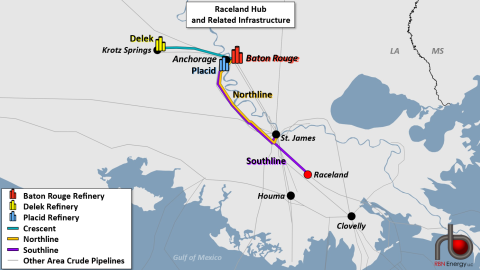The Raceland crude oil hub is far from Louisiana’s largest but might be positioned to earn a little more of the spotlight after Sentinel Midstream and ExxonMobil Pipeline formed a joint venture in December to enhance business for a few crude oil pipelines connecting Louisiana hubs, including Raceland. In today’s RBN blog, we examine the infrastructure and connectivity that makes up the Raceland hub southwest of New Orleans, see how it stacks up against some of its larger cousins in the state — namely, Clovelly and St. James — and discuss why activity at the hub could be poised to pick up steam.
Louisiana is home to about half a dozen crude oil hubs. Their connectivity to many centers of supply and demand provides the liquidity that traders desire, and that often translates to tradability. At the top of the state’s list of hubs are St. James and Clovelly, both of which are important delivery points for the trading of Gulf of Mexico (GOM) crudes, including regional benchmarks Light Louisiana Sweet (LLS) and medium-sour Mars Blend. A couple of other Louisiana hubs receive familiar grades: GOM-sourced Heavy Louisiana Sweet (HLS) at the Empire hub and medium-sour Poseidon (also from the GOM) at Houma. (All of these prices are tracked in our Crude Oil TradeView report and data files.)
In Louisiana Rain and Part of the Plan, we delved into the St. James hub’s extraordinary access to pipelines, rail and water (it lies just 60 miles up the Mississippi River from the Gulf). That connectivity allows barrels from the GOM and shale plays in Texas and the Midcontinent to flow in pretty much unabated. Its inbound pipes include the LOOP-to-Capline (LOCAP), Zydeco, Ship Shoal, Bayou Bridge and, more recently, the now-southbound Capline (see Against the Wind). St. James also has connections to a Department of Energy-owned pipe leased to ExxonMobil that provides bidirectional service between St. James and the Bayou Choctaw Strategic Petroleum Reserve (SPR) site southwest of Baton Rouge. Its outgoing pipes include connections to 11 Louisiana refineries.
For all its access, St. James’s storage capacity of around 36 MMbbl is just half that of Clovelly, an inland hub whose 72 MMbbl of above-ground storage tanks and underground caverns are operated by the Louisiana Offshore Oil Port (LOOP). Clovelly receives imported crudes and waterborne domestic grades from LOOP’s offshore marine terminal via the LOOP Pipeline, which is bidirectional to allow for crude exports out of LOOP — still the only Gulf Coast facility able to fully load Very Large Crude Carriers (VLCCs). Further, Clovelly gets well over 500 Mb/d of GOM production from the Mars and Endymion pipelines. It’s also a destination point for Shell’s Zydeco (formerly Ho-Ho) pipeline system, which can transport up to 350 Mb/d of West Texas Intermediate (WTI) and other crude grades east from terminals in Houston and Port Arthur/Beaumont in Texas and Lake Charles, LA. As we noted earlier, Clovelly is also the origin point for LOCAP, which sends supplies to the St. James hub.
Figure 1. Raceland Hub and Related Infrastructure. Source: RBN
Join Backstage Pass to Read Full Article









